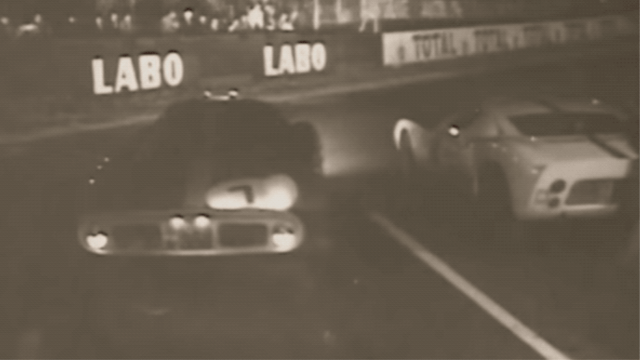At this point, it’s a bit boring to make a general statement like “racing used to be really frickin’ dangerous,” but every so often I’ll find myself surprised by the absolutely insane things race organizers used to make drivers do. Such as, for example, beginning an endurance race on public roads at the crack of midnight.
The 12 Hours of Reims was just such a race, the kind that only the French were really wild enough to dream up. I first heard about this event in Cars at Speed: The Grand Prix Circuit, a 1961 book by Robert Daley that touches on the history of the great Grand Prix circuits of the era, with a few deviations to talk about events like the Mille Miglia or the Targa Florio.
The wild event is mentioned off-hand as part of the larger Grand Prix weekend: “If one cares anything about any of the drivers, one is likely to be nervous the whole time the race is in progress. Since there are always two races — a twelve-hour sports-car race which begins at midnight Saturday and ends at noon Sunday — this can add up to a lot of fingernail biting.”
The event in question was held only a few times, once in 1926 and again between 1953 and 1967, with a few breaks sandwiched in between. In its latter incarnation, the race accompanied a Formula 1 event at Reims-Gueux, a treacherous triangular circuit built out of roads in the Champagne district of France. The track was over five miles in length, and it featured long straightaways that could last for over a mile where drivers were expected to reach the maximum speed potential of their cars.
Now imagine doing that at midnight. I’ll let a Motor Sport Magazine recap of the 1964 event paint the picture:
As the start was due to take place at midnight, headlights were obviously going to play a big part and the practice sessions allowed a certain amount of running after dark, for electrical tuning purposes. With the present-day GT Prototype cars on the very fast Reims circuit some remarkable lap speeds were put up and the top Ferraris and Lola-Fords were all lapping at well over 130 m.p.h., and for the first time for some years cars were braking hard going into the long right-hand bend after the pits, and some of the slower cars were not reaching a maximum speed equal to the average speed of the faster cars, but fortunately there was only a total of 37 starters, so the speed-differential problem was not as bad as it might have been. The main worry among the fast boys was the Le Mans-type start in the dark, and the opening laps, until they became accustomed to the dark.
You read that right; not only did this race start at midnight, but drivers were required to start “Le Mans-style,” which means that the race actually started without anyone behind the wheel. Drivers lined up on one side of the track with their cars parked on the other, and when the flag flew to start the race, they all had to run to their machines and get racing. That was a dangerous enough feat at Le Mans, where the race started at four in the afternoon.
It was even more dangerous in the shadows of Reims. Even though the front stretch of the track was well illuminated with floodlights, drivers often opted against securing their safety belts until they’d gotten up to speed; the whole goal was to get out ahead of everyone else, which meant there wasn’t time for piddling little safety concerns like seatbelts.
It’s hard to imagine what it must have been like behind the wheel, flying blind over the dark, bumpy public roads, braking hard for Reims’ tight corners, before leaping back into the eye-searingly bright front straight.
You can check out some old footage from one of the events on YouTube:
The absolutely insane event saw some motorsport legends take victory, including Graham Hill, Pedro Rodriguez, and Stirling Moss. The prize for winning the French Grand Prix was always quite generous; the overall purse was the largest of the year, and Robert Daley writes that appearance prizes alone could be $2,000 — or, adjusted for inflation today, over $20,000. Further, since the track was located in the Champagne district, there were also plenty of opportunities to win cases of bubbly throughout a race weekend. Endurance races often netted smaller winnings for its drivers, but at the vaunted 12 Hours of Reims, we can assume the prizes were still quite handsome.
You just, y’know, had to start your race in pitch darkness. No big deal!
Image: Planes, Trains & Automobiles
Want more Aussie car news? Here’s every EV we’ve reviewed in the last two years, all the EVs we can expect down under soon, and our guide to finding EV chargers across the country. Check out our dedicated Cars tab for more.
